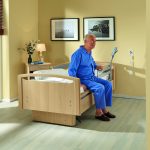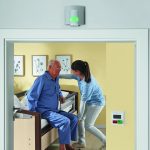Lack of exercise can lead to considerable complications for patients in the most severe care and intensive care units. However, a bilateral lateral tilt of up to 30° can significantly improve the patient’s state of health and thus contribute to rapid recovery. The lateral tilt is a great help not only for the patient but also for the nursing staff. A bed with lateral swivel, such as the multicare or latera thema, brings these advantages to everyday nursing care and the recovery process…
1. Kinetic therapy – fewer complications
Longer-term immobility leads to complications in the area of blood circulation and respiration due to the gravitational effect. For example, the capacity of the lungs is reduced. In addition, pneumonia and atelectasis can become serious problems. Due to the automatic lateral tilting with a rotation angle of up to 60°, the circulation and ventilation conditions in the lungs are frequently changed. The therapy cycles can be easily and individually adapted to each patient, so that the automatic kinetic therapy approach contributes to the active improvement of the state of recovery and the maintenance of vital functions.
2. Prevention of decubitus – treatment and prevention of pressure ulcers
Immobile patients in intensive care units have a high to very high risk of developing pressure ulcers due to their critical condition. Since the therapy of pressure ulcers can be very protracted, it is all the more important to consistently avoid risk factors and to treat decubitus effectively. The lateral swivel automatically moves the patient up to 30° in both directions, so that the continuous pressure change prevents pressure sores.
3. Facilitation of nursing work – savings in strength and time
94% of nurses in internal medicine and long-term care say that they suffer from back pain This shows beyond doubt that the daily care routine is physically very demanding. The care of patients who cannot mobilise themselves requires a lot of effort and time. The lateral swivel positions the patient laterally without much effort. This means that, among other things, basic care of the patient, bedding and dressing changes or wound care can be carried out without the need for any other care aids. The nursing staff is supported and medical processes are facilitated. In addition, the activities can be carried out more quickly and the nursing staff save a lot of time.
4. Easier access to the patient – mobilisation
The height adjustment and lateral swivelling of the bed help to mobilise patients. The lateral swivelling creates an inclined plane in the bed. This means that the patient can leave the bed with less effort. This therefore promotes early mobilisation and facilitates access to the patient. In addition, the swivelling supports the back-friendly transfer of the patient.
5. Well-being – simplified visitor reception and infant care
Immobile patients, who can receive visitors, have the possibility to optimally align the bed by lateral tilting. Communication with visitors is thus simplified. Furthermore, infant care is much easier and more comfortable in these lateral positions. Thus, the lateral pivoting increases the well-being of the patient.


